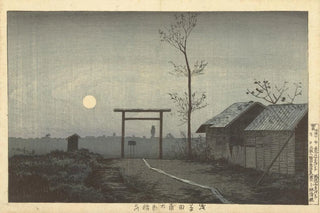Art print of the Sanctuary Taro Inari in the Rice Fields at Asakusa - Kobayashi Kiyochika


View from behind

Frame (optional)
The Taro Inari Shrine in the Rice Fields at Asakusa: a harmony between nature and spirituality
The art print of "The Taro Inari Shrine in the Rice Fields at Asakusa" by Kobayashi Kiyochika evokes a deep serenity, where nature and spirituality meet. The soft tones and meticulous details of the rice fields create a peaceful atmosphere, inviting contemplation. The canvas depicts a traditional shrine, surrounded by greenery, where visitors come to pray and rejuvenate. The artwork captures the ephemeral beauty of Japanese landscapes while emphasizing the importance of nature in Japanese culture. Every element of the composition seems to vibrate with a tranquil energy, transporting the viewer to a world of inner peace.
Kobayashi Kiyochika: a master of Japanese woodblock prints
Kobayashi Kiyochika, active in the late 19th century, is renowned for his art prints that blend tradition and modernity. Influenced by the rapid changes of his era, he successfully integrated contemporary elements while respecting the classical techniques of Japanese woodblock printing. Kiyochika was particularly interested in urban and natural landscapes, capturing the beauty of Japan during a period of transition. His work reflects not only his artistic talent but also a deep respect for Japanese culture and traditions. He is considered one of the most important artists of his time, having left a lasting legacy in the art world.
A decorative acquisition with multiple assets
The art print of "The Taro Inari Shrine in the Rice Fields at Asakusa" is a decorative piece that will add a touch of elegance to your interior, whether in a living room, office, or bedroom. Its printing quality ensures exceptional fidelity to the details and colors of the original work, allowing you to feel the tranquility it exudes. By incorporating this canvas into your decor, you create a calming and inspiring space, while paying homage to the beauty of Japanese landscapes. Its aesthetic appeal and cultural context make it a perfect choice for art and spirituality enthusiasts.

Matte finish

View from behind

Frame (optional)
The Taro Inari Shrine in the Rice Fields at Asakusa: a harmony between nature and spirituality
The art print of "The Taro Inari Shrine in the Rice Fields at Asakusa" by Kobayashi Kiyochika evokes a deep serenity, where nature and spirituality meet. The soft tones and meticulous details of the rice fields create a peaceful atmosphere, inviting contemplation. The canvas depicts a traditional shrine, surrounded by greenery, where visitors come to pray and rejuvenate. The artwork captures the ephemeral beauty of Japanese landscapes while emphasizing the importance of nature in Japanese culture. Every element of the composition seems to vibrate with a tranquil energy, transporting the viewer to a world of inner peace.
Kobayashi Kiyochika: a master of Japanese woodblock prints
Kobayashi Kiyochika, active in the late 19th century, is renowned for his art prints that blend tradition and modernity. Influenced by the rapid changes of his era, he successfully integrated contemporary elements while respecting the classical techniques of Japanese woodblock printing. Kiyochika was particularly interested in urban and natural landscapes, capturing the beauty of Japan during a period of transition. His work reflects not only his artistic talent but also a deep respect for Japanese culture and traditions. He is considered one of the most important artists of his time, having left a lasting legacy in the art world.
A decorative acquisition with multiple assets
The art print of "The Taro Inari Shrine in the Rice Fields at Asakusa" is a decorative piece that will add a touch of elegance to your interior, whether in a living room, office, or bedroom. Its printing quality ensures exceptional fidelity to the details and colors of the original work, allowing you to feel the tranquility it exudes. By incorporating this canvas into your decor, you create a calming and inspiring space, while paying homage to the beauty of Japanese landscapes. Its aesthetic appeal and cultural context make it a perfect choice for art and spirituality enthusiasts.
12,34 €






